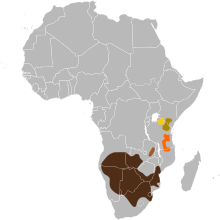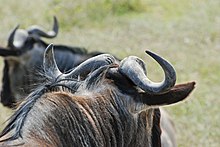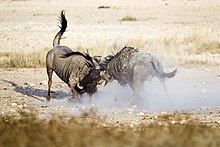Blue wildebeest
| Blue wildebeest Temporal range: Middle Pleistocene – present
| |
|---|---|

| |
| C. t. albojubatus In the Ngorongoro Crater, Tanzania
| |
| Scientific classification | |
| Domain: | Eukaryota |
| Kingdom: | Animalia |
| Phylum: | Chordata |
| Class: | Mammalia |
| Order: | Artiodactyla |
| Family: | Bovidae |
| Subfamily: | Alcelaphinae |
| Genus: | Connochaetes |
| Species: | C. taurinus
|
| Binomial name | |
| Connochaetes taurinus (Burchell, 1823)
| |
| Subspecies | |
|
C. t. albojubatus (Thomas, 1912) | |

| |
| Distribution of the subspecies: C. t. taurinus C. t. cooksoni C. t. johnstoni C. t. albojubatus C. t. mearnsi | |
The blue wildebeest (Connochaetes taurinus), also called the common wildebeest, white-bearded gnu or brindled gnu, is a large
The blue wildebeest is an herbivore, feeding primarily on short grasses. It forms herds which move about in loose aggregations, the animals being fast runners and extremely wary. The mating season begins at the end of the rainy season and a single calf is usually born after a gestational period of about 8.5 months. The calf remains with its mother for 8 months, after which it joins a juvenile herd. Blue wildebeest are found in short-grass plains bordering bush-covered acacia savannas in southern and eastern Africa, thriving in areas that are neither too wet nor too arid. Three African populations of blue wildebeest take part in a long-distance migration, timed to coincide with the annual pattern of rainfall and grass growth on the short-grass plains where they can find the nutrient-rich forage necessary for lactation and calf growth.[2][3]
The blue wildebeest is native to
Taxonomy and naming
The blue wildebeest was
Though the blue and black wildebeest are currently classified in the same genus, the former was previously placed in a separate genus, Gorgon. In a study of the
Subspecies
C. taurinus has five subspecies:[1][11][12]
- C. t. taurinus (Burchell, 1823), the blue wildebeest, common wildebeest, or brindled gnu is found in southern Africa. Its range extends from Namibia and South Africa to Mozambique (north of the Zambezi River) to southern Angola.
- C. t. johnstoni (Sclater, 1896), the Nyassaland wildebeest, occurs from Mozambique (north of the Zambezi River) to east-central Tanzania. It is now extinct in Malawi.
- C. t. albojubatus (Thomas, 1912), the eastern white-bearded wildebeest, is found in the Gregory Rift Valley(south of the equator). Its range extends from northern Tanzania to central Kenya.
- C. t. mearnsi (Heller, 1913), the western white-bearded wildebeest, is found in northern Tanzania and southern Kenya. Its range extends from the west of the Gregory Rift Valley to Speke Bay on Lake Victoria.
- C. t. cooksoni (Blaine, 1914), Luangwa Valleyin Zambia. Sometimes, it may wander into the plateau region of central Malawi.
In addition, the distinctive appearance of a western form, ranging from the Kalahari to central Zambia, suggests that subspecies mattosi (Blaine, 1825) may also prove distinct from subspecies taurinus. The western form can be recognised even at a distance by its upright mane, long beard, and minimal brindling.
Hybrids
The blue wildebeest is known to
Genetics and evolution
The
This species of wildebeest seems to have evolved around 2.5 million years ago.
Description


The blue wildebeest exhibits
Blue wildebeest have one of the most efficient locomotor muscles in terms of energy used for mechanical work and wasted as heat, with 62.6% of energy being converted into movement and the remainder in heat.[25] They can travel up to 80 km (50 mi) in 5 days without drinking water, with average temperatures of 38 °C (100 °F) in peak times of the day.[25]
Colouration
This broad-shouldered antelope has a muscular, front-heavy appearance, with a distinctive robust muzzle. Young are born tawny brown, and begin to take on their adult coloration at the age of 2 months. The adults' hues range from a deep slate or bluish-gray to light gray or even grayish-brown. The back and flanks are slightly lighter than the
In terms of skull length, the smallest subspecies of the blue wildebeest is the western white-bearded wildebeest.[18] It is also the darkest subspecies; the eastern white-bearded wildebeest is the lightest race.[8] Both subspecies possess a creamy white beard, whereas the beard is black in both the Nyassaland wildebeest and the common wildebeest. The longest muzzles are found in the Nyassaland wildebeest, and the shortest in female western white-bearded wildebeest.[18]
Horns
Both sexes possess a pair of large
Interdigital Glands
The blue wildebeest only has interdigital (hoof) glands in its fore legs. Analysis of chemical constituents from a free ranging animal in Zimbabwe (Cawston Block) showed this gland contains cyclohexanecarboxylic acid, phenol, 2-phenolethanol, and six short-chain carboxylic acids.[30]
Ecology and behavior

The blue wildebeest is mostly active during the morning and the late afternoon, with the hottest hours of the day being spent in rest. These extremely agile and wary animals can run at speeds up to 80 km/h (50 mph), waving their tails and tossing their heads.[21] An analysis of the activity of blue wildebeest at the Serengeti National Park showed that the animals devoted over half of their total time to rest, 33% to grazing, 12% to moving about (mostly walking), and a little to social interactions. However, variations existed among different age and sex groups.[8]
The wildebeest usually rest close to others of their kind and move about in loose aggregations. Males form bachelor herds, and these can be distinguished from juvenile groups by the lower amount of activity and the spacing between the animals. Around 90% of the male calves join the bachelor herds before the next mating season. Bulls become territorial at the age of four or five years, and become very noisy (most notably in the western white-bearded wildebeest) and active. The bulls tolerate being close to each other and one square kilometre (0.39 sq mi) of plain can accommodate 270 bulls. Most territories are of a temporary nature and fewer than half of the male population hold permanent territories. In general, blue wildebeest rest in groups of a few to thousands at night, with a minimum distance of 1–2 m (3–7 ft) between individuals (though mothers and calves may remain in contact).[8] They are a major prey item for lions, cheetahs, leopards, African wild dogs, hyenas, and Nile crocodiles.[21]
Female calves will stay with their mothers and other related females of the herd throughout their lives. Female individuals in a herd are from a wide range of ages, from yearlings to the oldest cow.[31] During the wet season, the females generally lead the herd towards nutritious areas of grasses and areas where predators can be avoided. This is to ensure that newborn calves have the highest chance of survival as well as gaining the most nutritious milk.[31]
Bulls mark the boundaries of their territories with heaps of dung, secretions from their scent glands, and certain behaviors. Body language used by a territorial male includes standing with an erect posture, profuse ground pawing, and horning, frequent defecation, rolling and bellowing, and the sound "ga-noo" being produced. When competing over territory, males grunt loudly, paw the ground, make thrusting motion with their horns, and perform other displays of aggression.[8]
Diet
The blue wildebeest is a
In a study of the dietary habits of the wildebeest, the animals were found to be feeding on the three dominant kinds of grass of the area, namely: Themeda triandra, Digitaria macroblephara, and Pennisetum mezianum. The time spent grazing increased by about 100% during the dry season. Though the choice of the diet remained the same in both the dry and the wet season, the animals were more selective during the latter.[34]
Reproduction

Male blue wildebeest become sexually mature at about 2 years of age, while females can conceive at 16 months if adequately nourished.
As they stake out their territories and compete for females, males exhibit rivalry. When they clash, they face up to each other with bent knees and exchange horn thrusts. Elaborate individual displays are made during their rivalry, and they may bellow, snort, and dig their horns into the ground. Once dominance has been established, each male attempts to lure the female into his domain.[35] During courtship, urination and low-stretch are common activities, and the male soon attempts to mount the female. A receptive female holds her tail to one side and stands still while copulation takes place. Matings may be repeated several times and may take place twice or more times within a minute. The male neither eats nor rests when a female is present in his territory, and during this time, the female keeps close to the male, often rubbing her head on his torso and sniffing his penis. While in season, a female may visit several territories and mate with several different males.[8]

The gestation period is about 8.5 months, and between 80 and 90% of the calves are born within a 3-week time period. Female wildebeest give birth in the middle of a herd rather than alone, and typically in the middle of the day. This allows time for the newborn to become steady on its feet before night falls and the predators become more active. Calves weigh about 19 kg (42 lb) at birth, and can usually stand on their own within a few minutes of birth. To escape predation, calves remain close to their mothers for a significant time, and may continue suckling until the next year's calf is nearly due. Male calves leave their mother at about 8 months and form herds with other male juveniles. In large female herds, 80% of the wildebeest offspring survive the first month, compared to a 50% survival rate in smaller herds.[8][35]
Diseases and parasites
The blue wildebeest is susceptible to
The animal can be host to a number of different parasites. In one study, blue wildebeest were found to be hosts to 13 species of
Distribution and habitat


The blue wildebeest is native to Kenya, Tanzania, Botswana, Zambia, Zimbabwe, Mozambique, South Africa, Eswatini, and Angola. Today, it is extinct in Malawi, but has been successfully reintroduced into Namibia.[1]
Blue wildebeest are mainly found in short-grass plains bordering bush-covered acacia savannas in southern and eastern Africa, thriving in areas that are neither too wet nor too arid. They can be found in habitats that vary from overgrazed areas with dense bush to open
Three African populations of blue wildebeest take part in long-distance migrations, timed to coincide with the annual pattern of rainfall and grass growth on the short-grass plains, where they can find the nutrient-rich forage necessary for lactation and calf growth.[2][3] The timing of the migration in both directions can vary considerably from year to year. At the end of the rainy season, they migrate to dry-season areas in response to a lack of drinking water. When the rainy season begins again a few months later, the animals trek back to their wet-season range.[39] These movements and access to nutrient-rich forage for reproduction allow migratory wildebeest populations to grow to much larger numbers than resident populations. Many long-distance migratory populations of wildebeest existed 100 years ago, but currently, all but three migrations (Serengeti, Tarangire, and Kafue) have been disrupted, cut off, and lost.[2][40]
Threats and conservation
Major human-related factors affecting populations include large-scale deforestation, the drying up of water sources, the expansion of settlements and poaching. Diseases of domestic cattle such as sleeping sickness can be transmitted to the animals and take their toll.[1] The erection of fences that interrupt traditional migratory routes between wet and dry-season ranges have resulted in mass death events when the animals become cut off from water sources and the areas of better grazing they are seeking during droughts.[1] A study of the factors influencing wildebeest populations in the Maasai Mara ecosystem revealed that the populations had undergone a drastic decline of around 80% from about 119,000 individuals in 1977 to around 22,000 twenty years later. The major cause of this was thought to be the expansion of agriculture, which led to the loss of wet-season grazing and the traditional calving and breeding ranges.[41] Similarly, drastic declines have recently occurred in the Tarangire wildebeest migration.[42]
The total number of blue wildebeest is estimated to be around 100,000. The population trend overall is unstable and the numbers in the
Relationship with humans

As one of the major herbivores of southern and eastern Africa, the blue wildebeest is one of the animals that draw tourists to the area to observe big game, and as such, it is of major economic importance to the region.[23] Traditionally, blue wildebeest have been hunted for their hides and meat, the skin making good-quality leather, though the flesh is coarse, dry, and rather tough.[44]
However, blue wildebeest can also affect human beings negatively. They can compete with domestic livestock for grazing and water and can transmit fatal diseases like rinderpest to cattle and cause epidemics among animals. They can also spread
An ancient carved slab of
References
- ^ . Retrieved 11 November 2021.
- ^ a b c Estes, R.D. (2014). The Gnu's World. UC Press. Archived from the original on 24 March 2017. Retrieved 15 September 2016.
- ^ (PDF) from the original on 27 July 2020. Retrieved 1 October 2019.
- ISSN 0260-9541.
- ^ OCLC 62265494.
- ^ Benirschke, K. "Wildebeest, Gnu". Comparative Placentation. Archived from the original on 15 March 2012. Retrieved 14 January 2014.
- ^ "Taurus". Encyclopædia Britannica. Merriam-Webster. Archived from the original on 2 April 2019. Retrieved 22 January 2014.
- ^ ISBN 978-0-520-08085-0. Archivedfrom the original on 14 March 2023. Retrieved 29 October 2016.
- ^ "Gnu". Merriam-Webster. Archived from the original on 6 November 2018. Retrieved 14 January 2014.
- PMID 1795096.
- ^ "Zambezian and Mopane woodlands". Terrestrial Ecoregions. World Wildlife Fund. Retrieved 29 June 2006.
- ITIS. Archivedfrom the original on 2 February 2014. Retrieved 22 January 2014.
- S2CID 23964988.
- hdl:11427/27315.
- ^ De Klerk, B. (2008), An osteological documentation of hybrid wildebeest and its bearing on black wildebeest (Connochaetes gnou) evolution (Doctoral dissertation)
- ISBN 978-0-521-84418-5.
- .
- ^ ISBN 978-1-4214-0329-8.
- ^ ISBN 978-1-77007-065-3.
- ISBN 978-1-4314-0871-9.
- ^ a b c d e f g Huffman, B. "Connochaetes taurinus : Brindled gnu, Blue wildebeest". Ultimate Ungulate. Archived from the original on 3 March 2016. Retrieved 22 January 2014.
- ISBN 978-1-4729-2531-2. Archivedfrom the original on 14 March 2023. Retrieved 25 December 2021.
- ^ a b c d e f Geraci, G. "Connochaetes taurinus : Blue wildebeest". University of Michigan Museum of Zoology. Animal Diversity Web. Archived from the original on 2 May 2014. Retrieved 22 January 2014.
- ISBN 0079095089.
- ^ hdl:10044/1/64452.
- ]
- ISBN 978-1-84162-347-4.
- ^ "Wildebeest (Connochaetes taurinus)". National Geographic. Archived from the original on 1 February 2014. Retrieved 22 January 2014.
- ^ ISBN 978-0-226-43725-5.
- .
- ^ from the original on 24 December 2021. Retrieved 24 December 2021.
- ISBN 978-0-521-53687-5.
- ^ Furstenburg, Deon (March 2013). "Focus on the Blue Wildebeest (Connochaetes taurinus)". South African Hunter. South Africa: SA Hunter.
- .
- ^ ISBN 978-0-226-54233-1.
- ISBN 978-3-642-61749-2.
- PMID 6676686. Archived from the original(PDF) on 16 October 2013. Retrieved 16 October 2013.
- PMID 17058441.
- S2CID 86335522.
- (PDF) from the original on 16 October 2021. Retrieved 7 September 2020.
- .
- (PDF) from the original on 16 October 2021. Retrieved 7 September 2020.
- ISBN 978-2-8317-0477-7.
- ISBN 978-0-8018-5789-8.
External links
- Blue Wildebeest Photo and Fact Sheet
- Connochaetes taurinus, Mammal Species of the World

